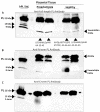Human Placental Tissue Contains A Placental Lactogen-Derived Vasoinhibin
- PMID: 35265784
- PMCID: PMC8900287
- DOI: 10.1210/jendso/bvac029
Human Placental Tissue Contains A Placental Lactogen-Derived Vasoinhibin
Abstract
Hormonal factors affecting the vascular adaptions of the uteroplacental unit in noncomplicated and complicated pregnancies are of interest. Here, 4 human placentas from women with and without preeclampsia (PE) were investigated for the presence of placental lactogen (PL)-derived, antiangiogenic vasoinhibin. Western blotting and mass spectrometry of placental tissue revealed the presence of a 9-kDa PL-derived vasoinhibin, the normal 22-kDa full-length PL, and a 28-kDa immunoreactive protein of undetermined nature. The sequence of the 9-kDa vasoinhibin includes the antiangiogenic determinant of vasoinhibin and could constitute a relevant factor in normal pregnancy and PE.
Keywords: placenta; placental lactogen; preeclampsia; vasoinhibin.
© The Author(s) 2022. Published by Oxford University Press on behalf of the Endocrine Society.
Figures

Similar articles
-
Plasmin generates vasoinhibin-like peptides by cleaving prolactin and placental lactogen.Mol Cell Endocrinol. 2021 Dec 1;538:111471. doi: 10.1016/j.mce.2021.111471. Epub 2021 Oct 1. Mol Cell Endocrinol. 2021. PMID: 34601001
-
A Dysregulation of the Prolactin/Vasoinhibin Axis Appears to Contribute to Preeclampsia.Front Endocrinol (Lausanne). 2020 Jan 9;10:893. doi: 10.3389/fendo.2019.00893. eCollection 2019. Front Endocrinol (Lausanne). 2020. PMID: 31998232 Free PMC article.
-
Immunometric and functional measurement of endogenous vasoinhibin in human sera.Front Endocrinol (Lausanne). 2024 Apr 29;15:1345996. doi: 10.3389/fendo.2024.1345996. eCollection 2024. Front Endocrinol (Lausanne). 2024. PMID: 38742198 Free PMC article.
-
An integrated model of preeclampsia: a multifaceted syndrome of the maternal cardiovascular-placental-fetal array.Am J Obstet Gynecol. 2022 Feb;226(2S):S963-S972. doi: 10.1016/j.ajog.2020.10.023. Epub 2021 Mar 9. Am J Obstet Gynecol. 2022. PMID: 33712272 Review.
-
Obesity and regulation of human placental lactogen production in pregnancy.J Neuroendocrinol. 2020 Nov;32(11):e12859. doi: 10.1111/jne.12859. Epub 2020 Jun 5. J Neuroendocrinol. 2020. PMID: 32500948 Review.
Cited by
-
Prolactin and vasoinhibin are endogenous players in diabetic retinopathy revisited.Front Endocrinol (Lausanne). 2022 Sep 9;13:994898. doi: 10.3389/fendo.2022.994898. eCollection 2022. Front Endocrinol (Lausanne). 2022. PMID: 36157442 Free PMC article. Review.
-
Morfofunctional and Molecular Changes in Placenta and Peripheral Blood in Preeclampsia and Gestational Diabetes Mellitus.Dokl Biol Sci. 2023 Dec;513(1):387-394. doi: 10.1134/S0012496623700722. Epub 2023 Dec 8. Dokl Biol Sci. 2023. PMID: 38066383 Free PMC article.
References
-
- González C, Parra A, Ramírez-Peredo J, et al. . Elevated vasoinhibins may contribute to endothelial cell dysfunction and low birth weight in preeclampsia. Lab Invest. 2007;87(10):1009-1017. - PubMed
-
- Leaños-Miranda A, Campos-Galicia I, Ramírez-Valenzuela KL, Chinolla-Arellano ZL, Isordia-Salas I. Circulating angiogenic factors and urinary prolactin as predictors of adverse outcomes in women with preeclampsia. Hypertension. 2013;61(5):1118-1125. - PubMed
-
- Leaños-Miranda A, Márquez-Acosta J, Cárdenas-Mondragón GM, et al. . Urinary prolactin as a reliable marker for preeclampsia, its severity, and the occurrence of adverse pregnancy outcomes. J Clin Endocrinol Metab. 2008;93(7):2492-2499. - PubMed
LinkOut - more resources
Full Text Sources
